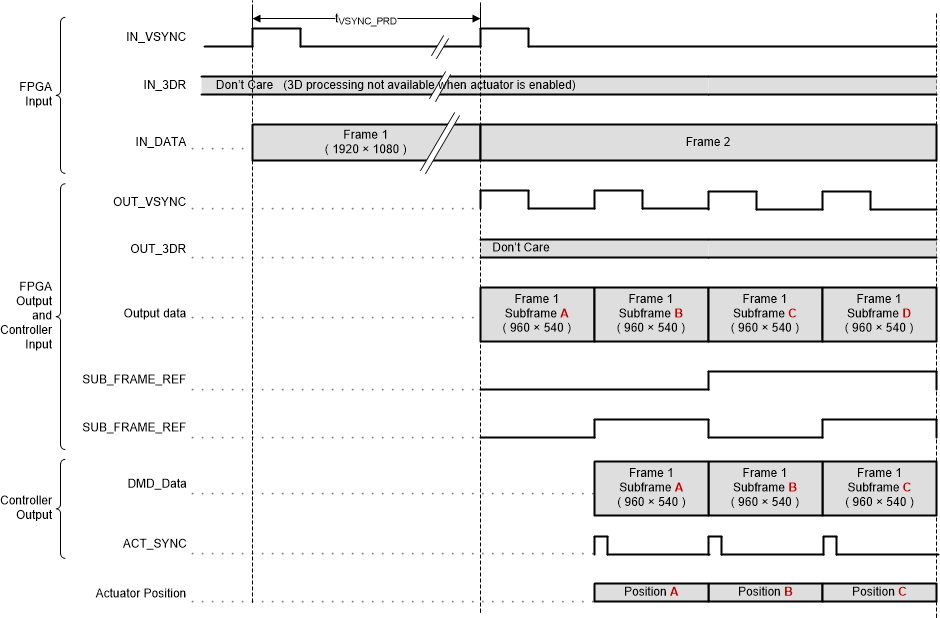DLPS156E january 2019 – april 2023 DLPC3436
PRODUCTION DATA
- 1 Features
- 2 Applications
- 3 Description
- 4 Revision History
- 5 Pin Configuration and Functions
-
6 Specifications
- 6.1 Absolute Maximum Ratings
- 6.2 ESD Ratings
- 6.3 Recommended Operating Conditions
- 6.4 Thermal Information
- 6.5 Power Electrical Characteristics
- 6.6 Pin Electrical Characteristics
- 6.7 Internal Pullup and Pulldown Electrical Characteristics
- 6.8 DMD Sub-LVDS Interface Electrical Characteristics
- 6.9 DMD Low-Speed Interface Electrical Characteristics
- 6.10 System Oscillator Timing Requirements
- 6.11 Power Supply and Reset Timing Requirements
- 6.12 Parallel Interface Frame Timing Requirements
- 6.13 Parallel Interface General Timing Requirements
- 6.14 Flash Interface Timing Requirements
- 6.15 Other Timing Requirements
- 6.16 DMD Sub-LVDS Interface Switching Characteristics
- 6.17 DMD Parking Switching Characteristics
- 6.18 Chipset Component Usage Specification
-
7 Detailed Description
- 7.1 Overview
- 7.2 Functional Block Diagram
- 7.3 Feature Description
- 7.4 Device Functional Modes
- 7.5 Programming
- 8 Application and Implementation
- 9 Power Supply Recommendations
- 10Layout
- 11Device and Documentation Support
- 12Mechanical, Packaging, and Orderable Information
Package Options
Mechanical Data (Package|Pins)
- ZVB|176
Thermal pad, mechanical data (Package|Pins)
Orderable Information
7.3.1.1 Input Frame Rates and 3-D Display Operation
Table 7-1 Supported Input Source Ranges (to FPGA)(1)(2)(3)
| INTERFACE | BITS PER PIXEL (max)(4) | IMAGE TYPE | SOURCE RESOLUTION RANGE(5) | FRAME RATE RANGE | |||
|---|---|---|---|---|---|---|---|
| HORIZONTAL | VERTICAL | ||||||
| Landscape | Portrait | Landscape | Portrait | ||||
| Parallel | 24 | 2D - qHD | 960 | N/A | 540 | N/A | 50 ± 2 Hz, 60 ± 2 Hz, 100 ± 2 Hz, 120 ± 2 Hz, 200 ± 2 Hz, 240 ± 2 Hz |
| Parallel | 24 | 2D - 1080p | 1920 | N/A | 1080 | N/A | 50 ± 2 Hz, 60 ± 2 Hz |
| Parallel | 24 | 3D - qHD(6) | 960 | N/A | 540 | N/A | 100 ± 2 Hz, 120 ± 2 Hz |
(1) The application must remain within specifications for all source interface parameters such as maximum clock rate and maximum line rate.
(2) The maximum DMD pixel display resolution is
1920 × 1080
while system actuator is enabled.
(3) To achieve the ranges stated, the firmware must support the source parameters. Review the firmware release notes or contact TI to determine the latest available frame rate and input resolution support for a given firmware image.
(4) Bits per pixel does not necessarily equal the number of data pins used on the DLPC34xx controller. Fewer pins are used if multiple clocks are used per pixel transfer.
(5) The
DLPC34x6 only supports
landscape orientation.
(6) 3D video is formatted as frame sequential.
The DLPC34x6 supports both 2D and 3D sources on the parallel interface. The frame and sub-frame timing for 2D sources is shown in Figure 7-1 while the frame timing for 3D sources is shown in Figure 7-3.
 Figure 7-1 2D Actuator Frame and Signal Timing
Figure 7-1 2D Actuator Frame and Signal Timing